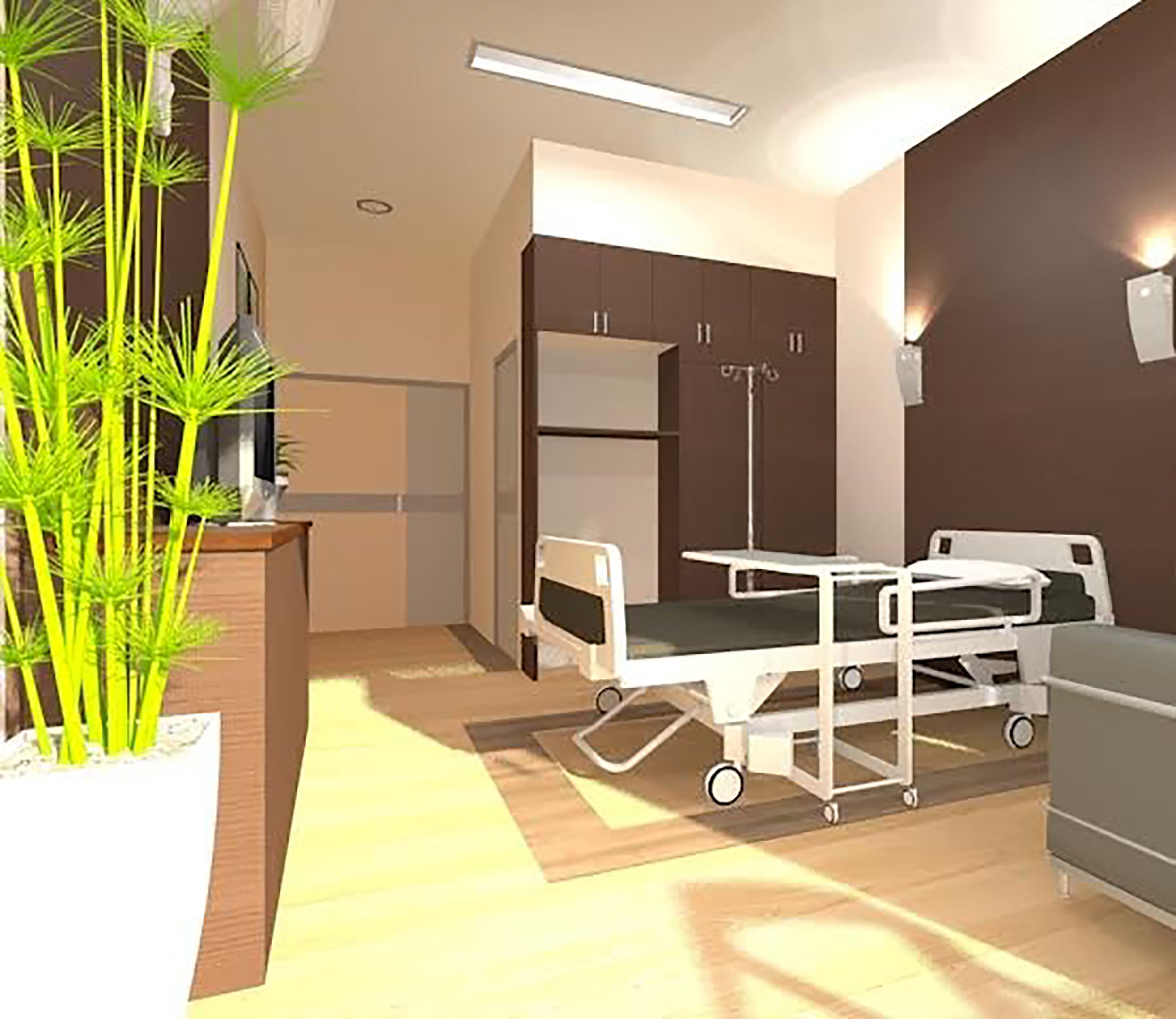อิทธิพลของสภาพแวดล้อมภายในห้องพักผู้ป่วย ในโรงพยาบาลชุมชนต่อการมองเห็นและการฟื้นฟู ของผู้สูงอายุชาวไทย
Main Article Content
บทคัดย่อ
การศึกษาครั้งนี้มีวัตถุประสงค์หลัก คือ เพื่อศึกษาอิทธิพลของปัจจัยทางด้านสภาพแวดล้อมภายในของห้องพักผู้ป่วยในโรงพยาบาลชุมชนต่อการมองเห็นและการฟื้นฟูสุขภาพของผู้สูงอายุชาวไทย การศึกษาได้ทำการทดลองในห้องทดลองและสำรวจในโรงพยาบาลชุมชน 2 แห่ง โดยได้ทำการศึกษาในห้องพักผู้ป่วยทั้งแบบพิเศษและแบบรวม การศึกษาประกอบด้วยการศึกษา 2 ส่วนหลัก ได้แก่ 1) การศึกษาอิทธิพลของปัจจัยทางด้านสภาพแวดล้อมภายในต่อการมองเห็นของผู้ป่วยสูงอายุ และ 2) การศึกษาอิทธิพลของปัจจัยทางด้านสภาพแวดล้อมภายในต่อการฟื้นฟูของผู้ป่วยสูงอายุ ผลการศึกษาชี้ให้เห็นปัจจัยที่มีอิทธิพลต่อการมองเห็นและการฟื้นฟูของผู้ป่วยสูงอายุในห้องพักผู้ป่วยโรงพยาบาลชุมชน อาทิ ความส่องสว่างบนชิ้นงาน ค่าความส่องสว่างที่ตา ค่าอุณหภูมิสีของแสง ค่าดัชนีความถูกต้องของสีของแสง และการมีวิวภายนอกการศึกษายังได้เสนอแนวทางการออกแบบสภาพแวดล้อมภายในของห้องพักผู้ป่วยของโรงพยาบาลชุมชนที่เหมาะสมกับการมองเห็นและการฟื้นฟูของผู้สูงอายุชาวไทย
Article Details
เอกสารอ้างอิง
BaHammam, A. (2006). Sleep in acute care units. Sleep and Breathing, 10 (1), 6–15.
Benedetti, F., et al. (2001). Morning sunlight reduces length of hospitalization in bipolar depression. Journal of Affective Disorders, 62 (3), 221–223.
Beauchemin, K. M. & Hays, P. (1996). Sunny hospital rooms expedite recovery from severe and refractory depressions. Journal of Affective Disorders, 40 (1–2), 49–51.
Beauchemin, K. M. & Hays, P. (1998). Dying in the dark: sunshine, gender and outcomes in myocardial infarction. Journal of the Royal Society of Medicine, 91 (7), 352–354.
Boyce, P. R. (1997). Illumination. In Salvendy, G. (Ed.). Handbook of human factors and ergonomics. (pp.673-698). New York: John Wiley.
Boyce, P. R. (2014). Human factors in lighting. London: Taylor and Francis.
Davis, R. G. & Garza, A. (2002). Task lighting for the elderly. Journal of the Illuminating Engineering Society, 30 (1), 20-32.
Demarco, A. & Clarke, N. G. (2001). An interview with Alison Demarco and Nichol Clarke: light and colour therapy explained. Complementary Therapies in Nursing and Midwifery, 7 (2), 95-103.
Edge, K. J. (2003). Wall color of patient’s room: effects on recovery. (Master’s thesis). Florida: University of Florida.
Hartig, T., et al. (2003). Tracking restoration in natural and urban field settings. Journal of Environmental Psychology, 23 (2), 109–123.
Iwata, T. & Tokura, M. (1998). Examination of the limitations of predicted glare sensation vote (PGSV) as a glare index for a large source: towards a comprehensive development of discomfort glare evaluation. Lighting Research and Technology, 30 (2), 81-88.
Kaiser, C. P. (2007). Careful fine art selection stimulates patient healing: serene nature views, rather than abstract art or no art, helps heart patients recover faster. Diagnostic Imaging, 2007 (1), 7–8.
Kaplan, R., & Kaplan, S. (1989). The experience of nature: a psychological perspective. New York: Cambridge University Press.
Kaplan, S. (1995). The restorative benefits of nature: toward an integrative framework. Journal of Environmental Psychology. 15, 169–182.
Katcher, A., Segal, H. & Beck, A. M. (1984). Comparison of contemplation and hypnosis for the reduction of anxiety and discomfort during dental surgery. American Journal of Clinical Hypnosis. 27 (1), 14–21.
Lewy, A.J., et al. (1998). Morning vs evening light treatment of patients with winter depression. Archives of General Psychiatry, 55 (10), 890–896.
Malkin, J. (1992). Hospital interior architecture: Creating healing environments for special patient populations. New York: John Wiley.
Martiny, K. (2004). Adjunctive bright light in non-seasonal major depression. Acta Psychiatry Scandinavia. 110 (425), 7–28.
Navil, A. & Mardaljevic, J. (2006). Useful daylight illuminances: a replacement for daylight factors. Energy and Buildings, 38 (7), 905–913.
Sherman, S. A., et al. (2005). Postoccupancy evaluation of healing gardens in a pediatric cancer center. Landscape and Urban Planning, 73, 167–183.
Smith, J. (2007). Design with nature. Healthcare Design. 7 (1), 37-41.
Speilberger, C. D. (1985). Assessment of state and trait anxiety: conceptual and methodological issues. The Southern Psychologist, 2 (4), 6-16.
Speilberger, C. D ., et al. (1999). Measuring anxiety and anger with the state-trait anxiety inventory and the state-trait anger expression inventory. In Marsuish, M.E. (Ed.), The use of psychological testing for treatment planning and outcomes assessment. (pp. 993–1021). Mahwah: Lawrence Erlbaum Associates.
Tuaycharoen, N. (2006). The reduction of discomfort glare from windows by interesting views. (Doctoral dissertation). Sheffield: The University of Sheffield.
Tuaycharoen, N. & Kornisranukul, W. (2013). Lighting for Thai elderly: an investigation of visual performance and discomfort glare. In Pathomthat, C. (Ed.). The Proceedings of 7th Lux pacifica 2013: cultural lighting 6th- 8th March, 2013 in Bangkok, Thailand. (pp.397-402). Bangkok: King Mongkut’s University of Technology Thonburi.
Tuaycharoen, N. & Tregenza, P.R. (2007). View and discomfort glare. Lighting Research and Technology, 39 (2), 185-200.
UCLA Office of Instructional Development. (1987). How the hospital environment affects recovery from illness. Study City: Angus Lake Productions.
Ulrich, R. S. (1984). View through a window may influence recovery from surgery. Science, 224 (4647), 420-421.
Ulrich, R. S. (1991). Effect of interior design on wellness: theory and recent scientific research. Journal of Health Care Interior Design, 3, 97-109.
Ulrich, R. S. (2008). Biophilic theory and research for healthcare design. In Kellert, S., Heerwagen, J. & Mador, M. (Eds.). Biophilic design: theory, science and practice. (pp. 535–544). New York: John Wiley Press.
Ulrich, R. S., et al. (2006). The environments impact on stress. In Marberry, S. (Ed.). Improving healthcare with better building design. (pp. 37–61). Chicago: Health Administration Press.
Ulrich, R. S., Lunden, O. & Eltinge, J. L. (1993). Effects of exposure to nature and abstract pictures on patients recovering from heart surgery. Psychophysiology, 30 (S1), 7-10.
Vernolia, C. (1988). Healing environments. Berkeley: Celestial Arts.
Wakamura, T. & Tokura, H. (2001). Influence of bright light during daytime on sleep parameters in hospitalized elderly patients. Journal of Physiological Anthropology and Applied Human Science, 20, 345–351.
Walch, J.M., et al. (2005). The effect of sunlight on post-operative analgesic medication usage: a prospective study of patients undergoing spinal surgery. Psychosomatic Medicine, 67 (1), 156–163.
Whitehouse, S., et al. (2001). Evaluating a children’s hospital garden environment: utilization and consumer satisfaction. Journal of Environmental Psychology, 21 (3), 301-314.
Zimring, C. M., et al. (2008). Implementing healthcare excellence: the vital role of the CEO in evidence-based design. HERD, 1 (3), 7–21.


